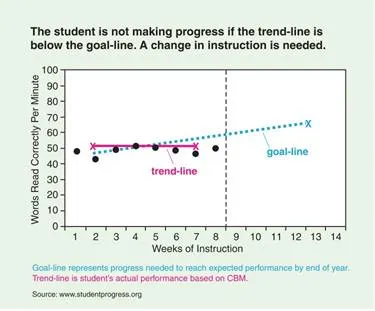How RTI monitors progress

By Amanda Morin
Expert reviewed by Elaine M. Niefeld, MA, MBA

At a glance
Progress monitoring is a key part of response to intervention (RTI).
The school assesses your child’s skills regularly and plots this data on a graph.
The trend line helps the school see if an intervention is working or if your child needs to be taught in a different way.
isn’t as complicated as it sounds. It’s how the school measures your child’s skills and keeps track of how well your child is responding to a certain teaching method or instructional intervention. Charting progress over time can help the school decide whether your child needs to be taught in a different way.
How progress monitoring works
Many schools use a process called response to intervention (RTI). RTI identifies struggling learners and uses targeted teaching to improve skills. A big part of RTI is measuring students’ skills using a scientifically based assessment. This means that researchers have studied the test or way of looking at your child’s skills and say it’s reliable.
A common form of progress monitoring is (CBM). CBM tracks your child’s progress in specific skill areas like reading, spelling, or math. The first test provides the “baseline.” This is the level of skill your child starts with. The teacher uses this baseline to help set a goal of where your child should be by the end of the intervention.
For example, early on in the school year, your child’s teacher may measure the reading skills of all the kids in the class. Let’s say this test shows that your child can correctly read 50 words per minute, and that this baseline puts your child at risk of failing for the year. The school’s RTI team chooses a reading intervention program and sets a goal for your child to read 70 words per minute after 12 weeks.
Your child will work with the teacher in small group lessons. The teacher will test your child’s reading skills weekly or every other week to keep track of progress toward the goal. Progress will be tracked on a graph, which will show how much progress your child is making over time.
What a progress monitoring graph looks like
A progress monitoring graph shows your child’s baseline, the goal being working toward, and how your child does on every assessment during the intervention period. Here’s how the graph is set up.
The y-axis: The vertical line on the left side of the graph represents the number of words per minute.
The x-axis: The horizontal line on the bottom of the graph represents the number of weeks of your child has been receiving a particular kind of reading instruction.
Your child’s baseline: This is the first dot, showing 50 words per minute. Every week your child’s progress is measured. Another dot is added showing how many words per minute your child read correctly during the latest assessment.
Your child’s goal line: This shows how much progress your child needs to make on average each week to reach the goal of reading 70 words per minute. This line is sometimes called a benchmark or aim line.
Your child’s trend line: This shows your child’s actual performance over time.

Focusing on the trend line
The trend line provides important information. It can help the RTI team decide what to do next. Here are three possibilities:
The trend line isn’t moving closer to the goal line. This is what’s being shown in the sample graph in this article. A trend line like this one indicates that not enough progress is being made. The RTI team needs to try a different instruction method that might work better.
The trend line is moving closer to the goal line. This kind of trend line shows a teaching intervention is working and should be continued.
The trend line meets the goal line. This means the intervention was successful and can be stopped. But your child’s progress should still be monitored.
Throughout the RTI process, the teacher should share your child’s progress with you. If you’re not getting regular updates, ask to get a copy of the graph after each assessment. As you work with your child’s teacher, keep in mind that words per minute isn’t all that there is to reading. There are other important skills, too, like how well kids understand what they read.
If you’re concerned about progress, you can request an evaluation to see if your child has a . Qualifying for special education services can give your child access to more resources at no cost to you.
Key takeaways
Progress monitoring is designed to show how much progress your child is making over time.
You can request a copy of these graphs after every skills assessment.
If you’re concerned your child isn’t making enough progress with RTI, you can ask for an evaluation for special education.
